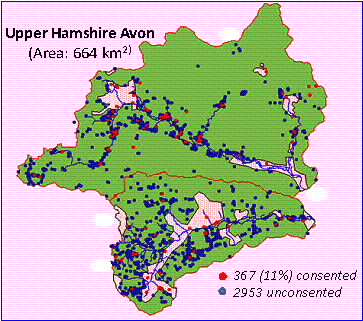 Accounting for phosphate inputs to water – septic tanks and other sources
Dr Linda May, Deputy Director, Water Programme, CEH, Edinburgh
Accounting for phosphate inputs to water – septic tanks and other sources
Dr Linda May, Deputy Director, Water Programme, CEH, EdinburghWASTEWATER RESEARCH AND INDUSTRY SUPPORT FORUM
Meeting 1st November 2012
Please note that for older reports some links will be to sites that are no longer active.
This was the Forum’s 48th meeting. It was held in CIWEM’s Boardroom in London. A roundup of members’ research included the following:
Chris Chubb told the meeting that
Pete Vale reviewed R&D being implemented by Severn Trent Water
Richard Williams, CEH
Gordon Jones, FWR
David Butler, Exeter University
Nick Orman
Konrad Bishop
Technical Presentations with members of CIWEM’s Wastewater Management Panel
 Accounting for phosphate inputs to water – septic tanks and other sources
Dr Linda May, Deputy Director, Water Programme, CEH, Edinburgh
Accounting for phosphate inputs to water – septic tanks and other sources
Dr Linda May, Deputy Director, Water Programme, CEH, Edinburgh
CEH discovered that the official statistics underestimate the number of on-site sewage treatment systems (STS) including septic tanks woefully
.Extrapolating from the areas that have been studied there are probably 1,400,000 in the UK but only 200,000 (14%) are registered. Many are close to watercourses, some discharge directly to the drainage network but the exact numbers and locations are unknown. In the sensitive Upper Avon catchment in Hampshire, an area of 644 km2, only 367 STS (11%) were consented and an additional 2953 were discovered.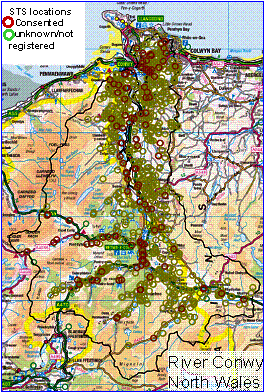
In Scotland from April 2006 all new domestic discharges require authorisation and existing unconsented discharges must be registered during house sale; a 3 month amnesty was given on registration. England and Wales started a similar programme in 2012, but England suspended it after a legal challenge. The map of consented STS and STS that have only been notified since the drive to improve knowledge of on-site sewage treatment in the Conwy Valley amply demonstrates the need for the programme.
IE has been prosecuted by the EU for bad management of STS. There are probably 500,000 STS in IE. House building dispersed throughout the countryside was a feature of the “Celtic Tiger” boom. In most cases the groundwater table is too high. Many old STS take roof runoff in addition to foul sewage.
CEH found that when a stream passed an STS, the soluble reactive phosphate (SRP) in the water increased 3 or 4-fold. The boron load paralleled the phosphate and load (kg/d) in the Chittern Brook in Wiltshire which suggests the sources were the same; the only likely source of boron was detergent, which implicates discharges from STS, not diffuse pollution from farmland.
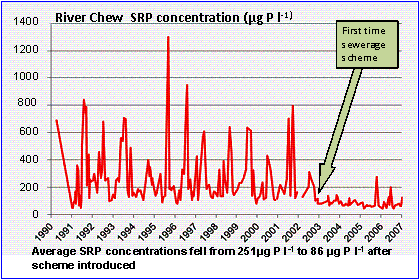 The dramatic reduction in SRP in the River Chew in Somerset, England after Wessex Water introduced first time sewerage is convincing evidence that STS had been having a significant effect which had been unrecognised previously when the conventional wisdom was that diffuse contributions from agriculture must be the balance when point sources such as wastewater treatment works had been accounted for. Ignorance of STS and their contribution has led to mistaken policy decisions.
The dramatic reduction in SRP in the River Chew in Somerset, England after Wessex Water introduced first time sewerage is convincing evidence that STS had been having a significant effect which had been unrecognised previously when the conventional wisdom was that diffuse contributions from agriculture must be the balance when point sources such as wastewater treatment works had been accounted for. Ignorance of STS and their contribution has led to mistaken policy decisions.
Because of (re)development the number of STS is increasing. The evidence is mounting that STS discharges are a hitherto unrecognised problem at local and catchment scales and that discharges can occur under high and low flows. These affect stream P concentrations. Catchments with high densities of STS are the most vulnerable. Particulate-P is converted to soluble-P within an STS and therefore the P discharged from STS is very bioavailable, much more than P bound to soil particles in field runoff, consequently the risk of ecological impact is greater. When the contribution of STS is unrecognised the pollution is attributed incorrectly to agriculture and consequently attenuation strategies are ineffective. Removing or upgrading STS appears to improve water quality but technical solutions to P discharge issues are desperately needed. Iron dosing or discharging through steel slag have been found to reduce SRP concentrations.
Reinventing the toilet
Prof Andrew Wheatley, Water Engineering, Loughborough University
The Bill and Melinda Gates Foundation challenged researchers to reinvent the toilet so that developing countries could leapfrog the hard infrastructure that has served developed countries so well but which is so expensive. Gates criteria were that no grid connection should be required, it should be safe, affordable, not smell, not make a noise, be easy to use (in developing countries) and nobody should have to touch untreated toilet waste. Eight teams qualified and developed designs. The design from Loughborough multidisciplinary team came second and progresses to further development. Loughborough selected self-contained continuous thermal hydrocarbonisation because it satisfies the Gates’ criteria, it does not involve drying, it uses lower temperatures than direct heating, it captures VOCs and the products are safe and useful. Carbonisation takes 6 hours at 160°C or at 2 hours 180°C. Nitrogen, phosphorus and potassium are all recovered and even chlorine is recovered to disinfect the recovered water. A possible future development is to include processing of food waste, which would improve the economics by increasing the organic input. |
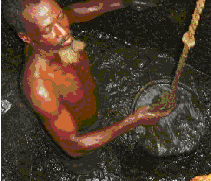 Sewage handling in India today 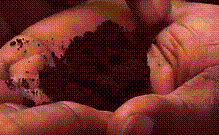 Loughborough's CTHC product |
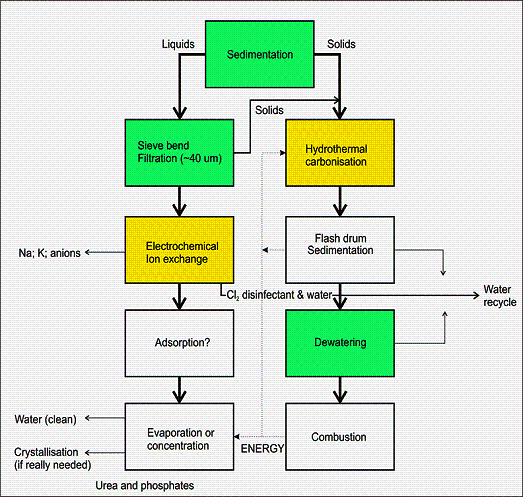
Discussion: CIWEM’s letter to Minister Benyon and Ofwat’s reply
Stephen Palmer, CIWEM WwMP and Alison Fergusson, Ofwat
CIWEM wrote to Defra Minister Richard Benyon that it had concerns about “unintentional but significant barriers we perceive, to sustainable asset investment and development in the UK water industry.” In discussion it transpired that this perception really stemmed from the misperceptions of some water companies and that Ofwat welcomes sensitivity analyses and whole life costings in business plan submissions.
Discussion: advancing science / public interaction
Alastair Chisholm and Tim Evans, CIWEM
There was a brief discussion around the subjects of engaging with the media and public in matters of controversial science. It was agreed that much of the research commissioned and funded by the water industry is cut off from the interactive development of science because it is published behind high pay-walls and that effectively it is unavailable to the majority of researchers [and also policy makers and media] therefore it is neither part of the incremental development of science nor considered by policy makers or the media.